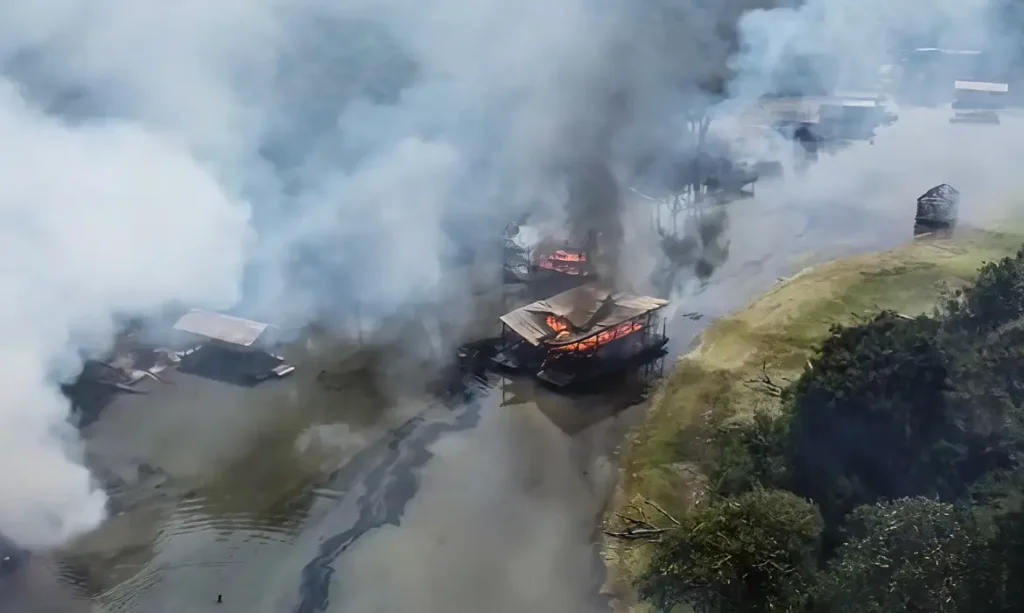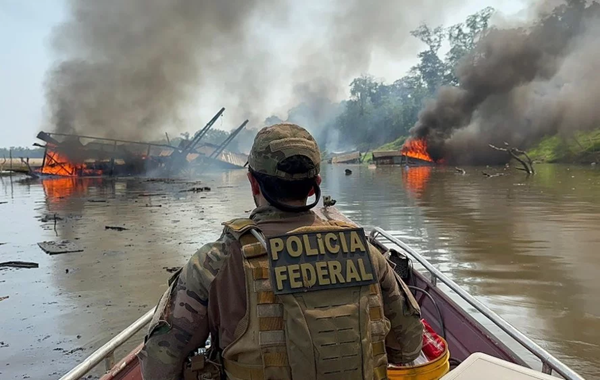SUMMARY
On 21 August, the city of Humaitá, located in the Amazonas state, Brazil’s North Region, and inside the so-called “Legal Amazon”, was thrust into chaos as a violent confrontation erupted between illegal miners and police forces. Even though other similar events have happened in the past, this marked a significant escalation in ongoing tensions between law enforcement and those involved in illicit mining activities in the region. Clashes spread throughout the city, disrupting businesses, putting people and assets at risk, and almost leading to the complete loss of public order. At the same, the incident exposed insufficiencies in the local security forces and the criminal powers that have been dragging the North Region and especially the “Legal Amazon” into a spiral of violence behind its growing criminal rates.
The Miners’ Revolt
The conflict began around 16h00, in the city’s port when Federal Police (PF) agents were returning from an operation to repress illegal mining and burn mining dredges in the Madeira River and its tributaries, Aripuanã and Manicoré. The agents had just burned 223 dredges and accomplished a new phase of operation “Prensa”. The action ignited outrage among miners.

According to Major Anderson Saif, from the Amazonas Military Police (AM-PM), the miners communicated via WhatsApp. Local forces could not hold them back and hundreds of them invaded the port and waited for the federal officers to disembark. Upon arriving at the city’s port, the policemen were attacked. Outnumbered, they returned to the river and escaped.
After the failed action against the PF, the mob turned against local authorities, public property, and everything on their way. The miners marched through the streets. The city of only 57.473 inhabitants (IBGE-2022) became a battleground. They attempted to torch the mayor’s house and the City Hall. The local military police, which was left alone by the PF, faced the mob at the local square, where miners launched rocks, used fireworks, and shot at law enforcement. The clashes lasted several hours, engulfing parts of the city in smoke and chaos. The city’s Public Ministry and other agencies were damaged as well.
The situation only improved after the arrival of police forces from Rondônia, which sent 50 men from the crowd control troop. The city had to request help from the neighboring state because it is quite isolated from Amazonas’ capital, Manaus. The quickest response would come from Porto Velho (RO).
The violence disrupted the lives of Humaitá’s residents. Many local businesses were forced to close, and panic spread among families seeking to escape the turmoil. Local authorities reported 9 people injured, among both police officers and miners. 16 individuals were arrested.
Fragile Security Scenario
The incidents exposed deficiencies from local security forces and challenges posed by the conditions observed in the Legal Amazon. Such factors can be developed into four points: weaknesses in police forces, the region’s geographical configuration, expansion of factions to the North, and their involvement with illegal activities other than drug trafficking.

According to the study Cartographies of Violence in the Amazon, published this year with data from 2023 and 2022, the Civil Police, responsible for solving crimes and reducing impunity, in the Legal Amazon region suffer from insufficient specialized civil police stations and some even have very few in total, including the regular ones. The nine states that form the region have 946 specialized non-specialized police stations and 303 are specialized. States like Acre have only 39 in total.
The specialized units, essential for fighting organized crime, environmental crimes, drug trafficking, money laundering, corruption, and more, suffer from bad distribution and low numbers. In all nine states, there are only 53 units. To fight organized crime, there are 16, but 9 are in Tocantins and none in Maranhão. To fight drug trafficking, there are 11, and once more not a single one in Maranhão.
In terms of personnel, there is one civil policeman for every 1,877 inhabitants across the nine states. The more inhabitants per police officer, the less well-equipped the population would be. In this sense, the most worrying scenarios are in Pará, where there are 3,449 inhabitants per police officer, and in Mato Grosso, where the ratio is 2,887. Another way to calculate this is through the number of officers per Km². The relation is 339 Km² per officer, in comparison to 93 Km² in the country.
In the Military Police, the same issue of low numbers of facilities and concentration of specialized units in some states appears. Regarding the number of officers, the ratio of inhabitants per officer for the Legal Amazon is 460, better than that for the whole of Brazil, 525. However, when the ratio of Km² per officer is analyzed, the lack of personnel in the region becomes evident. There are 83 km² per police officer, while in Brazil this value drops to 21 km².
The Legal Amazon has 5 mi Km² (IBGE) – 60% of the country – and a terrain that is hard to access, cut by a lot of rivers and dense forest. On top of that, there are cities spread all over the territory, many quite isolated. Thus, security depends on specialized vehicles, reinforcements, and help from federal units. This issue emerged during the episode on 21 August, when Rondônia state had to help Humaitá. Still, these reinforcements took 2 hours to arrive. In this regard, the work showed a proportionally low number of aircraft, boats, and 4×4 vehicles to move agents. For instance, São Paulo, 20 times smaller than the Legal Amazon, has within its military police 29 choppers and 636 boats. Meanwhile, the nine states have 25 and 143 respectively.
To make matters worse, the region is in the middle of a process that marks the expansion and settlement of the large and powerful gangs from the Southwest, often by absorbing or associating with local small groups. The Cartographies of Violence points to the presence of at least 22 different criminal groups in at least 178 cities in the Brazilian Legal Amazon, corresponding to 23.05% of the total number of cities.

The arrival of the big gangs has strengthened and professionalized local groups. New criminal routes have emerged, as well as connections with other illicit activities, such as mining and logging, posing enormous challenges to the institutions responsible for maintaining order. The process also fuels existing rivalries and imports those from the region of origin of the arriving gangs, which are mainly the First Capital Command (PCC) and the Red Command (CV). The results are seen in lethal intentional crimes. The Brazilian Public Security Forum (FBSP) reported that in 2022, the rate of intentional violent deaths in the cities that make up the Legal Amazon was 33.8 for every group of 100,000 inhabitants, while in Brazil, it was 23.3, 45% lower.
Perspectives
The incident in Humaitá is emblematic of a larger struggle facing Brazil as it grapples with the dual pressures of environmental protection and economic activity, especially in the Amazon forest.

Legal Amazon’s great offer of natural resources, the possibilities of high and quick returns with mining, the continuously increasing gold prices, and years of high unemployment rates strengthen illegal activities, and the criminals behind them. And when authorities come to enforce the law, they are often seen as a threat to the communities’ subsistence, leading to violent reactions.
The presence of the big gangs involved in these illegal activities takes the challenge to another level. Associated with that, the numbers of violent deaths reveal that the security scenario of common crimes remains a growing concern.
Despite the bigger effort to fight illegal activities in the Legal Amazon by the current central government, and the decrease in intentional violent deaths in 2022 in the area – -1.7% –, these vectors of criminal force show no reversion in their directions and continue to pressure local law enforcement. And, certainly, the local security forces, with such deficiencies, will suffer to respond to this under the current conditions. Therefore, any business that wishes to flourish in the area, must understand the specificities of the location where it is going to operate and prepare itself. Companies have to verify the threats and risks to which they are exposed and understand the certain need for additional security, beyond that already offered by the state.




